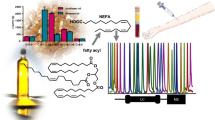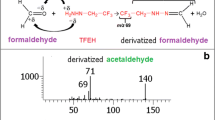Abstract
High-performance thin-layer chromatography‒mass spectrometry (HPTLC‒MS) method was developed for the estimation of epimers (+)-catechin (CA) and (‒)-epicatechin (ECA) in Onosma bracteatum Wall. Resolving these epimers is challenging and so method optimization was done for the selection of the stationary phase and the mobile phase to achieve their coherent separation. To further increase the reliability of the obtained densitometric results, HPTLC–MS analysis was performed. The genus Onosma L. is a species-rich genus that exhibits complex patterns of morphological and karyological diversity, and highly debatable taxonomic approaches. Thus, many similar species are described based on morphological differences and often quite ambiguous. To facilitate the identification of O. bracteatum, separation was achieved using pre-coated silica gel 60 F254 HPTLC plate as the stationary phase and a mixture of diisopropyl ether–ethyl acetate–formic acid (9.0:0.2:0.7, V/V) as the mobile phase for the separation of epimers CA and ECA. Sample preparation, mobile phase selection and optimization were given importance to manage good resolution (RF) of these markers. Flavan-3-ols CA and ECA were identified and confirmed on the basis of RF and in situ UV and MS overlaid spectra with respective standards. The method was validated for linearity, inter-day precision, intra-day precision, repeatability, accuracy, specificity, limit of detection, and limit of quantification. The average recoveries for epimers CA and ECA from ethyl acetate extract fraction (MEF) were found 98.86 and 99.03% indicating the good reproducibility for each marker. The proposed validated HPTLC method is simple, accurate and reproducible and is the first report on the separation and quantification of the epimers CA and ECA in O. bracteatum using HPTLC–MS.



Similar content being viewed by others
References
Vaidya B (1982) Some controversial drugs in Indian medicine. Chaukhambha Orientlia, Varanasi
Khare P (2007) Indian medicinal plants: an illustrated dictionary. Springer, Berlin
Kirtikar K, Basu B (1935) Indian medicinal plants, 2nd edn. International Book Distributors, New Delhi
Kaur S, Kumar A, Kaur V, et al (2020) Antioxidant phytoconstituents from Onosma bracteata Wall. (Boraginaceae) ameliorate the CCl4 induced hepatic damage: in vivo study in male wistar rats. Front Pharmacol 11:1301. https://doi.org/10.3389/fphar.2020.01301
Kumar N, Kumar R, Kishore K (2013) Onosma L.: a review of phytochemistry and ethnopharmacology. Pharmacogn Rev 7:140–151. https://doi.org/10.4103/0973-7847.120513
Dandiya PC, Arora RB (1957) A phytochemical and pharmacological study of Onosma bracteatum Wall. J Am Pharm Assoc 46:111–114. https://doi.org/10.1002/jps.3030460210
Nadkarni K (2002) Indian materia medica, 3rd edn. Popular Prakashan Pvt Ltd, Bombay, p 871
Umer F, Yanjun P, Dejene D, et al (2019) Novel anti-aging benzoquinone derivatives from Onosma bracteatum Wall. Molecules 24:1428. https://doi.org/10.3390/molecules24071428
Ahmad B, Ali N, Bashir S, et al (2009) Parasiticidal, antifungal and antibacterial activities of Onsoma griffithi. Afr J Bot 8:5084–5087. https://doi.org/10.4314/ajb.v8i19.65228
Walter C, Shinwari ZK, Afzal I, et al (2011) Antibacterial activity in herbal products used in Pakistan. Pak J Bot 43:155–162
Imran H, Rahman AU, Sohail T, et al (2018) Onosma bracteatum Wall: a potent analgesic agent. Bangladesh J Med Sci 17:36–41. https://doi.org/10.3329/bjms.v17i1.35276
Menghani E, Sudhanshu RN, Mittal S (2011) Free radical scavenging capacity and antioxidant activity of Onosma bracteatum. Int J Pharm Res Dev 4:16–20
Badruddeen FS, Siddiqui HH, Haque SE, et al (2012) Psychoimmunomodulatory effects of Onosma bracteatum Wall. (Gaozaban) on stress model in sprague dawley rats. Exp Res 6:1356–1360
Choudhary GP (2012) Wound healing activity of the ethanolic extract of Onosma bracteatum Wall. Int J Pharm Chem Sci 1:1035–1037
Rajapara AM, Bhatt VP, Shah MB (2021) Phytochemical and pharmacological investigation on Onosma bracteatum Wall. Asian J Biol Life Sci 10:141–149. https://doi.org/10.5530/ajbls.2021.10.21
Yanjun P, Yanan L, Rui I, et al (2021) Ehretiquinone from Onosma bracteatum Wall. exhibits antiaging effect on yeasts and mammals through antioxidative stress and autophagy induction. Oxid Med Cell Longev. https://doi.org/10.1155/2021/5469849
Dalluge JJ, Nelson BC (2000) Determination of Tea Catechins. J Chromatogr A 881:411–424. https://doi.org/10.1016/S0021-9673(00)00062-5
Vovk I, Simonovska B, Vuorela P, Vuorela H (2002) Optimization of separation of (+)-catechin and (−)-epicatechin on cellulose thin-layer chromatography plates. J Planar Chromatogr-Mod TLC 15:433–436. https://doi.org/10.1556/JPC.15.2002.6.8
Wang KB, Liu ZH, Huang JA, Fu DH, Liu F, Gong YS, Wu XS (2009) TLC separation of catechins and theaflavins on polyamide plates. J Planar Chromatogr Mod TLC 22:97–100. https://doi.org/10.1556/jpc.22.2009.2.4
Fecka I, Cisowski W, Luczkiewicz M (2001) Determination of catechin and epicatechin in an extract from Uncaria tomentosa bark by TLC with chemically modified stationary phases. J Planar Chromatogr Mod TLC 14:405–409
Vovk I, Simonovska BS, Andrensek P, Vuorela H (2003) Rotation planar extraction and rotation planar chromatography of oak (Quercus robur L.) bark. J Chromatogr A 991:267–274. https://doi.org/10.1016/s0021-9673(03)00271-1
Friedrich H, Wiedemeyer H (1976) Quantitative determination of the tannin-precursors and the tannins in Ephedra helvetica. Planta Med 30:223–231. https://doi.org/10.1055/s-0028-1097722
Poblocka-Olech L, Krauze-Baranowska M, Wiwart M (2007) HPTLC determination of catechins in different clones of the genus Salix. J Planar Chromatogr Mod TLC 20:61–64. https://doi.org/10.1556/jpc.20.2007.1.10
Sharma OP, Bhat TK, Singh B (1998) Thin-layer chromatography of gallic acid, methyl gallate, pyrogallol, phloroglucinol, catechol, resorcinol, hydroquinone, catechin, epicatechin, cinnamic acid, p-coumaric acid, ferulic acid and tannic acid. J Chromatogr A 822:167–171. https://doi.org/10.1016/S0021-9673(98)00490-7
Glavnik V, Simonovska B, Vovk I (2009) Densitometric determination of (+)-catechin and (−)-epicatechin by 4-dimethylaminocinnamaldehyde reagent. J Chromatogr A 1216:4485–4491. https://doi.org/10.1016/j.chroma.2009.03.026
International Conference on Harmonization, Q2 (R1) (2005) Validation of Analytical Procedures, Text and Methodology, Geneva
Acknowledgements
The authors wish to thank L. M. College of Pharmacy, Ahmedabad, and SAIF, GTU, Ahmedabad, for support and to provide facilities to carry out research work.
Author information
Authors and Affiliations
Corresponding author
Ethics declarations
Conflict of interest
The authors declare no conflicts of interest.
Rights and permissions
About this article
Cite this article
Rajpara, A., Gandhi, N., Bhatt, V. et al. Simultaneous determination of epimers (+)-catechin and (‒)-epicatechin in Onosma bracteatum Wall. using high-performance thin-layer chromatography‒mass spectrometry method. JPC-J Planar Chromat 35, 89–95 (2022). https://doi.org/10.1007/s00764-022-00157-5
Received:
Accepted:
Published:
Issue Date:
DOI: https://doi.org/10.1007/s00764-022-00157-5




